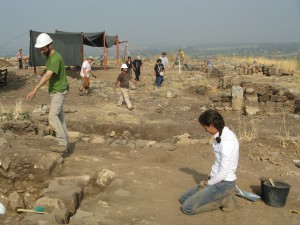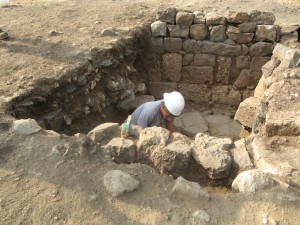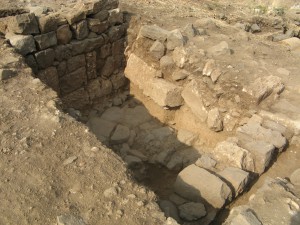Two weeks ago, when our digging began in earnest, I and four other team members were assigned to an area northeast of the temple complex, an area sure to disclose something about Omrit’s broader pattern of occupation. Though Omrit was in continuous use at least from the second century BCE through the thirteenth century CE, the nature and geographic extent of this use demand further study. Past excavations north of the complex in have uncovered evidence of Byzantine industrial activity, of a Roman colonnade, and of a Roman bathhouse, all suggesting a nearby settlement for the site’s maintenance.
I’ve not quite accepted that our group reached bedrock Thursday. On the one hand, helping to dig our two-by-four meter patch to its end has made me feel satisfyingly, scientifically thorough in my work. On the other, so many pieces of the area’s history remain missing that I wish the ground had yielded more information—or, I should write, more information that is immediately readable. My frustration has reminded me that thoroughness in archaeology is a fraught notion, as it’s rarely feasible to sift every bit of a site’s dirt. I’ve also been reminded, however, that the thoroughness archaeology can achieve depends no more on systematic field labor than on the careful synthesis of whatever data the ground gives up, necessarily a slow process.

Jason and Lydia inspecting our area from the north, with the rest of the excavations in the background.
We revealed the foundations of two east-west-oriented walls in our area, one at the patch’s north end and the other at the south. Between these walls, where we concentrated our digging efforts, we discovered not only fragments of marble facing, of painted wall plaster, of fieldstone floor mosaic, of patinated glass, and of animal bone, but also hundreds of pottery sherds that grew in size as we approached bottom. And near that bottom, well over a meter from the surface, we uncovered three bronze coins, several iron nails, an iron dagger, a small iron bell, a cache of what seem to be fossilized seeds, and two bead-like obsidian pieces, possibly spindle whorls. The remains came to light amid layers of the same rough basalt and limestone blocks out of which the walls are built.
From our material finds and from the area’s stratigraphy, or deposition history, we can so far draw a mere two conclusions with confidence: that the walls are Byzantine and that they eventually fell on a compacted surface between them. An expert dated most of our pottery to the fourth or fifth century, but thanks to the durability of ancient clayware, there’s no guarantee that our examples were used or deposited when they were produced. So when exactly and why did the walls go up and collapse? When exactly and how was the space between them used? How is our area related to the rest of the site? Answering these fundamental questions will require much more work, if not more excavation. Our coins, for instance, must undergo months of cleaning before they can even be read.
We in the trench have of course seized the opportunity to spin our own tales about the little world we’ve unearthed. One of the pleasures of our group’s long days in the field is our conversation, made to the steady rhythm of clanging picks and trowels. As Lydia asks astute questions, Elliot spouts witticisms, Caroline shares her archaeologically experienced perspective, and our leader Jason offers insightful summations before exhorting us to dig quickly, that conversation often addresses the ground at our feet. What if this space was simply a waste disposal between buildings, we’ve imagined? What if it was a storage room, one buried in the terrible earthquake that struck the Galilee in the eighth century? What if some sensitive animal became a hero in the collapse, sacrificing its life to save a woman wearing inexpensive but chic jewelry that she lost in the drama? After all, if the evidence can’t refute it…


